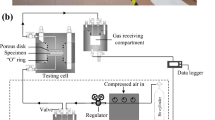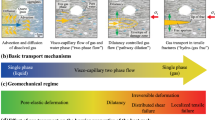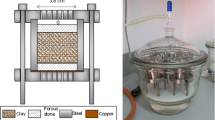Abstract
Controlled flow-rate gas injection experiments have been performed on pre-compacted samples of KBS-3 specification Mx801 buffer bentonite using helium as a safe replacement for hydrogen. By simultaneously applying a confining pressure and backpressure, specimens were isotropically-consolidated and fully water-saturated under pre-determined effective stress conditions, before injecting gas using a syringe pump. Ingoing and outgoing gas fluxes were monitored. All tests exhibited a conspicuous threshold pressure for breakthrough, somewhat larger than the sum of the swelling pressure and the backpressure. All tests showed a post-peak negative transient leading to steady-state gas flow. Using a stepped history of flow rate, the flow law was shown to be nonlinear. With the injection pump stationary (i.e. zero applied flow rate), gas pressure declined with time to a finite value. When gas flow was reestablished, the threshold value for gas breakthrough was found to be significantly lower than in virgin clay. There is strong evidence to suggest that the capillary pressure for the penetration of interparticle pore space of buffer bentonite is of such a magnitude that normal two-phase flow is impossible. Gas entry and breakthrough is therefore accompanied by the development of microcracks which propagate through the clay from gas source to sink. The experiments suggest that these pathways open under high gas pressure conditions and partially close if gas pressure falls, providing a possible explanation of the nonlinearity of the flow law.
Similar content being viewed by others
References
S. Horseman, J. Higgo, J. Alexander and J. Harrington. Water, gas and solute movement in argillaceous media. Prepared by BGS for NEA SEDE Working Group on Measurement and Physical Understanding of Groundwater Flow Through Argillaceous Media. Rept. No. CC-96/1, OECD Nuclear Energy Agency, Paris, 1996, 290 pp, 26 figs.
M. Sen, S. Horseman and J. Harrington. Further studies on the movement of gas and water in an overconsolidatedclay. EU MEGAS Project Phase 2. Fluid Processes Group, British Geological Survey, Technical Rept. No. WE/96/8, 1996.
Acknowledgement
The experimental study is funded by Svensk Kirbrinslehantering AB (SKB), Stockholm, Sweden, and the researchers wish to thank this company for its continuing financial support. The paper is published with the permission of the Director, British Geological Survey (NERC).
Author information
Authors and Affiliations
Rights and permissions
About this article
Cite this article
Horseman, S.T., Harrington, J.F. & Sellin, P. Gas Migration in MX80 Buffer Bentonite. MRS Online Proceedings Library 465, 1003–1010 (1996). https://doi.org/10.1557/PROC-465-1003
Published:
Issue Date:
DOI: https://doi.org/10.1557/PROC-465-1003




